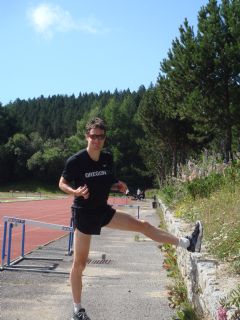The latest paper I have read on the topic concerns the effect of static stretching on energy cost & running endurance performance in a group of trained endurance runners. The study, conducted by Jacob Wilson & his co-workers at Florida State University, was published in the Journal of Strength & Conditioning Research back in September 2010 & makes for interesting reading.
The experimental group consisted of 10 middle- & long-distance trained male athletes from the Florida State University track team & was conducted during the off-season. The subjects attended the lab on 3 separate occasions throughout the study. The initial visit was where screening & testing took place - heart rate, body composition & VO2 max data was collected. Then subsequently subjects were randomly allocated to a stretching experimental group or a control group where they rested quietly before the exercise bout. The exercise bout consisted of a 60 minute treadmill run, with the first, pre-load 30 minute period conducted at 65% of the subject's VO2 max & the second 30 minutes where the subject was asked to run as far as they could in the time available. The final session saw the subjects switch groups & repeat the test.
The authors found that 8 of the 10 subjects ran significantly further (3.4%) in the non-stretching group (6.0 /- 1.1km) versus the stretching group (5.8 /- 1.0km), whilst the mean energy expended was significantly greater in the stretching group (425 /- 55kcals) compared to the non-stretching group (405 /- 53kcals).
It must be noted, however, that this was a very small experimental population but more importantly that the subjects were exclusively male athletes. A study by Beaudoin & Blum in 2005 found that the negative relationship between energy cost & flexibility is not apparent in female athletes as it is in males, therefore the findings of this study cannot be extrapolated to a female endurance population.
Secondly, there is no way of establishing which components of the running mechanics changed as the authors did not collect objective data on stiffness, ground contact times or stride length to analyse. There is also no acknowledgement of normal personal warm-up routine in the study & given the athletes were all members of the same track team, it is plausible that they follow the same warm-up routine in their regular training, which may or may not include static stretching.
Nevertheless, the paper poses some interesting questions & is worth reading to consider whether or not your warm-up routines are appropriate for the athletes you are training.
Comments below as usual, please!

